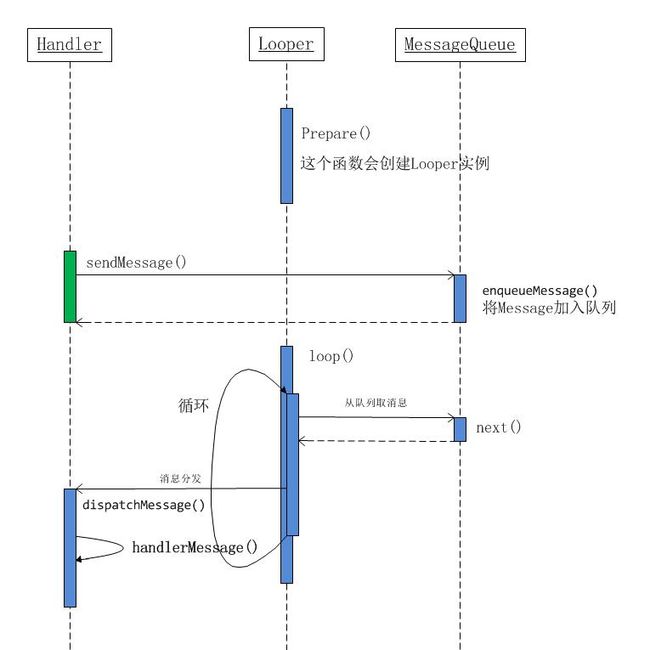引子
在子线程中利用Handler机制来实现UI更新想必都不会陌生,最近项目中注意到了一种Thread中转换到ActivityThread的方式:
new Thread(new Runnable){
@Override
public void run(){
Handler mHandler = new Handler(Looper.getMainLooper);
mHandler.post(new Runnable){
@Override
public void run(){
//操作UI线程
}
}
}
}
与常见Message方式不同,而是直接转到UI线程,有更大的灵活性,但实现方式感觉有点懵,Handler是如何实现线程的转换的,就下定决心看看Android消息机制的原理。
所以写这篇文章主要是记录消息机制的原理,并结合上例分析过程,让自己对Handler机制有一个比较清晰的认识。
实现过程
这里有三个类:
MessageQueue:消息队列,主要提供了消息队列的插入(enqueueMessage)与弹出(next)功能;
Looper:主要实现无限循环的读取MessageQueue中是否有新Message,查找到会分发(dispatchMessage)给Handler处理,否则一直等待;
Handler:Handler实现向MessageQueue发送Message,另外Looper接收到Message后调用Handler的处理,即具体实现Android消息机制的类。
先来看一张图,此图很好的说明了Handler消息机制的实现过程(非常好的UML序列图,我就偷懒不画了,出自 http://blog.csdn.net/oracleot/article/details/19163007)
图上很清楚的示出,关于线程转换的过程:Handler发送消息(post或sendMessage),只需取得对应的Handler实例,没有耗时处理,不限定线程;而一个线程若想Handler消息机制,初始化该线程的Handler前,需要创建自己的Looper与对应的QueueMessage,loop()方法在该线程上循环查询消息,当Looper接收到新消息会调用Handler相应的处理方法,这个过程发生在Handler所属线程中;
而引子示例中,可以通过Looper.getMainLooper获取UI线程的静态Looper是因为Android系统在创建Activity时已经初始化Looper,属于一个特例。因此我们不止可以利用Hanlder机制实现对UI线程的操作,而可以实现转换到任意线程处理消息。
下面来看看这三个类的主要实现方法:
MessageQueue
主要完成消息队列的管理,主要方法插入与弹出,分别对应enqueueMessage与next两个方法
- 先来看enqueueMessage
可以看到MessageQueue并非实现一个队列,而是一个单链表,而该方法主要实现一个Message的插入,而参数when指定了Message的发送时间。
boolean enqueueMessage(Message msg, long when) {
if (msg.target == null) {
throw new IllegalArgumentException("Message must have a target.");
}
if (msg.isInUse()) {
throw new IllegalStateException(msg + " This message is already in use.");
}
synchronized (this) {
if (mQuitting) {
IllegalStateException e = new IllegalStateException(
msg.target + " sending message to a Handler on a dead thread");
Log.w(TAG, e.getMessage(), e);
msg.recycle();
return false;
}
msg.markInUse();
msg.when = when;
Message p = mMessages;
boolean needWake;
if (p == null || when == 0 || when < p.when) {
// New head, wake up the event queue if blocked.
msg.next = p;
mMessages = msg;
needWake = mBlocked;
} else {
// Inserted within the middle of the queue. Usually we don't have to wake
// up the event queue unless there is a barrier at the head of the queue
// and the message is the earliest asynchronous message in the queue.
needWake = mBlocked && p.target == null && msg.isAsynchronous();
Message prev;
for (;;) {
prev = p;
p = p.next;
if (p == null || when < p.when) {
break;
}
if (needWake && p.isAsynchronous()) {
needWake = false;
}
}
msg.next = p; // invariant: p == prev.next
prev.next = msg;
}
...
}
return true;
}
- 再来看next:
next实现了一个无限循环的方法,无消息一直处于阻塞。当有消息时,返回该条消息并从链表中移除。
Message next() {
...
for (;;) {
if (nextPollTimeoutMillis != 0) {
Binder.flushPendingCommands();
}
nativePollOnce(ptr, nextPollTimeoutMillis);
synchronized (this) {
// Try to retrieve the next message. Return if found.
final long now = SystemClock.uptimeMillis();
Message prevMsg = null;
Message msg = mMessages;
if (msg != null && msg.target == null) {
// Stalled by a barrier. Find the next asynchronous message in the queue.
do {
prevMsg = msg;
msg = msg.next;
} while (msg != null && !msg.isAsynchronous());
}
if (msg != null) {
if (now < msg.when) {
// Next message is not ready. Set a timeout to wake up when it is ready.
nextPollTimeoutMillis = (int) Math.min(msg.when - now, Integer.MAX_VALUE);
} else {
// Got a message.
mBlocked = false;
if (prevMsg != null) {
prevMsg.next = msg.next;
} else {
mMessages = msg.next;
}
msg.next = null;
if (DEBUG) Log.v(TAG, "Returning message: " + msg);
msg.markInUse();
return msg;
}
} else {
// No more messages.
nextPollTimeoutMillis = -1;
}
// Process the quit message now that all pending messages have been handled.
if (mQuitting) {
dispose();
return null;
}
}
...
}
Looper
Looper 扮演着消息循环的角色,不停地从MessageQueue查询是否有新消息,如果有的话立刻执行,否则阻塞。
- Looper 的创建
首先创建Looper需要调用静态prepare方法,源码中利用了ThreadLocal这个类,大概的功能是:可以将Looper所处的线程作为Key,而Looper实例作为Value,实现每个每个线程Looper的独立存储。
prepare方法中通过get判断该线程是否已存在Looper,若存在会报错,不存在的话会将该线程与该Looper以键值存储,从而保证了只有一个Looper实例。
static final ThreadLocal sThreadLocal = new ThreadLocal();
private Looper(boolean quitAllowed) {
mQueue = new MessageQueue(quitAllowed);
mThread = Thread.currentThread();
}
private static void prepare(boolean quitAllowed) {
if (sThreadLocal.get() != null) {
throw new RuntimeException("Only one Looper may be created per thread");
}
sThreadLocal.set(new Looper(quitAllowed));
}
- loop函数的分析
这个方法是Loop的最主要的功能方法,实现无限循环读取MessageQueue.next,无消息时处于等待阻塞状态,查询到新消息会立即执行msg.target.dispatchMessage(msg)交与Handler处理。跳出循环的唯一方式是quit方法被调用时queue.next会返回null,会直接跳出循环,因此在使用Looper是因记得quit的调用。
而msg.target.dispatchMessage(msg),这句,调用了msg的target对象的dispatchMessage函数,其实target就是Handler对象,具体下节会有分析。
public static void loop() {
final Looper me = myLooper();
if (me == null) {
throw new RuntimeException("No Looper; Looper.prepare() wasn't called on this thread.");
}
final MessageQueue queue = me.mQueue;
// Make sure the identity of this thread is that of the local process,
// and keep track of what that identity token actually is.
Binder.clearCallingIdentity();
final long ident = Binder.clearCallingIdentity();
for (;;) {
Message msg = queue.next(); // might block
if (msg == null) {
// No message indicates that the message queue is quitting.
return;
}
// This must be in a local variable, in case a UI event sets the logger
Printer logging = me.mLogging;
if (logging != null) {
logging.println(">>>>> Dispatching to " + msg.target + " " +
msg.callback + ": " + msg.what);
}
msg.target.dispatchMessage(msg);
if (logging != null) {
logging.println("<<<<< Finished to " + msg.target + " " + msg.callback);
}
// Make sure that during the course of dispatching the
// identity of the thread wasn't corrupted.
final long newIdent = Binder.clearCallingIdentity();
if (ident != newIdent) {
Log.wtf(TAG, "Thread identity changed from 0x"
+ Long.toHexString(ident) + " to 0x"
+ Long.toHexString(newIdent) + " while dispatching to "
+ msg.target.getClass().getName() + " "
+ msg.callback + " what=" + msg.what);
}
msg.recycle();
}
}
Handler
先来看Handler是如何创建的,创建时处理化了两个引用,mQueue与消息插入有关,callback与消息处理有关,具体分析看后面。
public Handler() {
this(null, false);
}
public Handler(Callback callback, boolean async) {
if (FIND_POTENTIAL_LEAKS) {
final Class klass = getClass();
if ((klass.isAnonymousClass() || klass.isMemberClass() || klass.isLocalClass()) &&
(klass.getModifiers() & Modifier.STATIC) == 0) {
Log.w(TAG, "The following Handler class should be static or leaks might occur: " +
klass.getCanonicalName());
}
}
mLooper = Looper.myLooper();
if (mLooper == null) {
throw new RuntimeException(
"Can't create handler inside thread that has not called Looper.prepare()");
}
mQueue = mLooper.mQueue;
mCallback = callback;
mAsynchronous = async;
}
- 消息插入部分
首先是通过当前线程的Looper来获取MessageQueue实例,获取实例的目的主要是将消息放入链表中,这里就用到了之前说的enqueueMessage插入,并可指定插入时间,Handler中sendMessage,post等发送消息的方法就是利用这个原理:
public final boolean sendMessage(Message msg)
{
return sendMessageDelayed(msg, 0);
}
public final boolean sendMessageDelayed(Message msg, long delayMillis)
{
if (delayMillis < 0) {
delayMillis = 0;
}
return sendMessageAtTime(msg, SystemClock.uptimeMillis() + delayMillis);
}
public boolean sendMessageAtTime(Message msg, long uptimeMillis) {
MessageQueue queue = mQueue;
if (queue == null) {
RuntimeException e = new RuntimeException(
this + " sendMessageAtTime() called with no mQueue");
Log.w("Looper", e.getMessage(), e);
return false;
}
return enqueueMessage(queue, msg, uptimeMillis);
}
private boolean enqueueMessage(MessageQueue queue, Message msg, long uptimeMillis) {
msg.target = this;
if (mAsynchronous) {
msg.setAsynchronous(true);
}
return queue.enqueueMessage(msg, uptimeMillis);
}
- 消息发送部分
在Looper中提过,Looper从队列里面取出消息后,调用Handler的dispatchMessage函数,现在看下实现:
public void dispatchMessage(Message msg) {
if (msg.callback != null) {
handleCallback(msg);
} else {
if (mCallback != null) {
if (mCallback.handleMessage(msg)) {
return;
}
}
handleMessage(msg);
}
}
这里有两个回调,msg.callback指的是Handler.post中的Runnable,即若是post提交的消息直接给handleCallback处理,实现很简单:
private static void handleCallback(Message message) {
message.callback.run();
}
然后第二个mCallback是构建Handler时传入的引用,在使用上就是我们最熟悉的handleMessage方法,我们经常通过重写该方法实现消息处理逻辑。也就是说若不存在msg.callback,就会在收到消息后调用我们定义的handleMessage。这时执行的代码已经切换到Handler所在线程~!
关于自己
其实是第一次花时间把自己看的源码分析用心记录下来,所以虽然是热门知识,也希望能分享出来,当作激励自己继续去进步、专研。
我的博客,期待大家的指证与交流~
